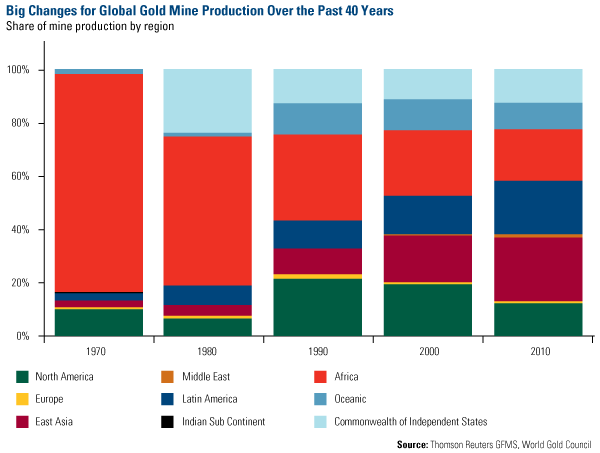Finding evidence to pop the talk of a gold bubble is much easier than finding a needle in a haystack. There are enough needles of evidence out there to fill a pin cushion. The latest Gold Demand Trends Report from the World Gold Council (WGC) contained two salient visuals of how the dynamics of the global gold market have shifted from the West to the East over the past 40 years. Today we’ll take a look at supply, and tomorrow we’ll dive into demand.
This chart illustrates Africa’s incredibly shrinking gold production over the past 40 years. Africa's mine production was down by the continent's main producer, South Africa, which enjoyed a 100-year reign as the world's largest gold producer. At the height of South Africa’s gold mining empire in 1970, the country produced 79 percent of “free world” gold, according to the WGC. Free world does not include gold production from the communist bloc, which would decrease South Africa’s share to roughly 62 percent based on estimates. North America was the only other region to produce a significant share of gold, which was about 10 percent.
This chart illustrates Africa’s incredibly shrinking gold production over the past 40 years. Africa's mine production was down by the continent's main producer, South Africa, which enjoyed a 100-year reign as the world's largest gold producer. At the height of South Africa’s gold mining empire in 1970, the country produced 79 percent of “free world” gold, according to the WGC. Free world does not include gold production from the communist bloc, which would decrease South Africa’s share to roughly 62 percent based on estimates. North America was the only other region to produce a significant share of gold, which was about 10 percent.

Over the past four decades, South Africa’s gold mining sector has been plagued by frequent labor strikes and a lack of necessary resources, such as water and electricity. In addition, South Africa’s production has suffered from a substantial decline in ore grades of gold deposits. According to the 2011 CPM Gold Yearbook, the country’s average ore grade peaked around 12.49 grams per metric ton in 1968 and has been on a steady decline since then. By 2009, the average grade of gold mined fell below 2 grams per metric ton, an 85 percent drop.
Lower ore grades require a miner to chew through more rock to recover the gold. A South African mine today would have to move roughly 10 times the tonnage of rock to produce the same amount of gold.
While mine production in the 1970s was a one-man show, today’s global mine production is a collective effort. No single country supplies more than 14 percent of the world’s total, according to the WGC. The WGC says, “This lack of concentration serves as a buffer against supply risks stemming from individual countries, a facet of gold that differentiates from the other precious metals, which have significantly higher production concentration.” The biggest growth over the past 40 years has come from China, which has seen its mine production rise from obscurity to become the world’s largest producer. Interestingly enough, this production increase hasn’t been able to keep pace with the country’s insatiable demand for gold.
While mine production in the 1970s was a one-man show, today’s global mine production is a collective effort. No single country supplies more than 14 percent of the world’s total, according to the WGC. The WGC says, “This lack of concentration serves as a buffer against supply risks stemming from individual countries, a facet of gold that differentiates from the other precious metals, which have significantly higher production concentration.” The biggest growth over the past 40 years has come from China, which has seen its mine production rise from obscurity to become the world’s largest producer. Interestingly enough, this production increase hasn’t been able to keep pace with the country’s insatiable demand for gold.
For the rest of that story, tune in tomorrow when we’ll discuss how China’s demand for gold is reshaping the industry.
